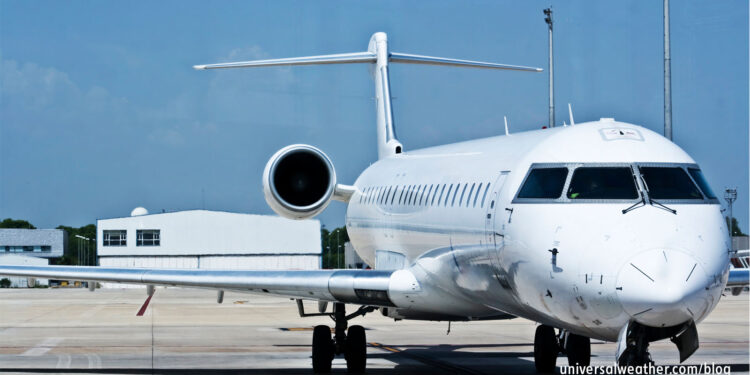Large Aircraft Operations in North and Latin America: Part 1 – Top Considerations

This business aviation blog post is part of a series on large aircraft logistics for trips to North and Latin America.
Business aircraft operations utilizing large aircraft face unique requirements and challenges in terms of trip pre-planning and day-of-operation considerations. To address these potential planning and support issues when operating large aircraft within North and Latin America, it’s recommended to use a 3rd-party provider and local ground handlers familiar with these types of operations.
The following is an overview of top considerations for business aircraft operators planning large aircraft operations in North and Latin America:
1. Defining large aircraft
The large aircraft category includes the ACJ A318-A320, BBJ 737/757, Embraer Lineage 1000, and MD 80/83 up to wide bodies including the Airbus A330/340 and Boeing 767/777/787/747-400 and 747SP. Many business operators travel with these aircraft for private non-revenue purposes, as well as charter (non-scheduled commercial) use – transporting delegations, sports teams, etc. Additionally, there are many head of state and royal family applications for large aircraft.
2. Top issues on the ground
Some of the considerations with respect to large aircraft operations include:
- High prices for ground services
- Lack of Ground Support Equipment (GSE)
- Not enough ground support personnel on staff to support the aircraft, crew, passengers, luggage, and cargo at time of arrival/departure
- Lack of handling expertise with these types of aircraft
- Aircraft parking considerations and/or limitations
- Hotel and local transport arrangements for crew
- Additional customs, immigration, and quarantine clearance requirements
- Different types of permissions – e.g., Transportation Security Administration waivers, landing permits
- Pets and weapons onboard
3. Recommended planning lead times
Ideally, 10-14 days’ lead time is best in terms of large aircraft trip planning, depending upon destination and GSE requirements. For travel within North and Latin America, it’s advisable to allow at least five business days for permit lead time. At least 48 hours’ advance notification is recommended for fuel uplifts and in-flight catering orders.
4. Airport limitations
Special permission may be required to operate large aircraft to certain airports. Some airports, such as Teterboro (KTEB), will not accept certain large aircraft. Generally, you’ll need minimum runway length of 6,500 feet for larger aircraft movements, and parking areas/taxiways must have required load bearing capacity. Airport/taxiway requirements must also be kept in mind when choosing alternate airports. Wingspan will be a consideration for parking at many locations. While a BBJ 737-800 has wingspan of just 112 feet, and the B757-200 has a relatively compact span of 124 feet, you’re dealing with 200-foot spans with B787, B777-300ER, or vintage 747SP equipment. Additionally, fire category coverage, sufficient for the large aircraft and type of operation, must be considered.
5. Documentation
In addition to standard aircraft/crew documentation, additional information may be needed for large aircraft at certain airports. Some countries, including Argentina, require an interior floor plan and seating chart to prove the flight is private non-revenue or charter, as opposed to scheduled commercial. If you’re carrying cargo, additional paperwork will be required. You may also need to carry additional documentation, such as specific liability insurance and declarations on any hazardous materials and/or human remains, etc. that you may have onboard.
6. Prepare in advance
Effective pre-planning is best practice for avoiding large aircraft issues at destinations. Always provide your ground handler with a complete schedule and crew/passenger information in advance, along with all required documentation and fuel/service requirements. GSE requirements should be communicated to your ground handler well in advance of the day of operation. Consider having a 3rd-party representative on site (onsite supervisory support) prior to arrival and after departure to ensure that needed services are provided and all charges are accurately reconciled.
7. Cost considerations
Depending on the airport, your type of aircraft, time of day, and aircraft service requirements, non-fuel support costs may be two to five times more expensive than for traditional larger business jets. If specialized GSE equipment must be brought in, this can add $5,000-30,000 to handling costs. In-flight catering charges may be also much higher, as you might require a lift truck, special packaging, etc.
It’s important, from a cost perspective, to negotiate fuel pricing in advance and not on day of operation. Furthermore, consider requesting cost estimates in advance for all required services, aircraft parking, and support.
We’ve also seen cases where costs of services have more than doubled after a large aircraft lands, for reasons that a 3rd-party provider cannot always easily explain – for instance, because of having to source specialized equipment last-minute. For this reason, close oversight is required so that the operator is not billed at prices way beyond normal costs of services.
Conclusion
When operating large aircraft, in North and Latin America, you’ll want to ensure that all ground services happen simultaneously, as they’re supposed to, so that you are able to depart on time. Having a supervisory handling representative available may be a worthwhile option to ensure all arrangements happen efficiently and that you’re not overcharged for services.
Questions?
If you have any questions about operating large aircraft to North and Latin America, contact me at jerribanks@univ-wea.com or charlesgabb@univ-wea.com.
Stay tuned for Part 2, which covers more large aircraft logistics when operating to North or Latin America.




